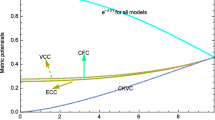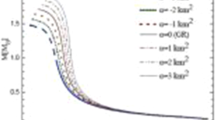Abstract
The tidal disruption of stars in the vicinity of massive black holes is discussed in the context of \(\varLambda \)-gravity. The latter provides an explanation to the Hubble tension as a possible consequence of two Hubble flows, the local and global ones. The bunch of notions that play role for the considered tidal effect are obtained, along with the rate of the disrupted stars. The role of pulsars is emphasized due to their ability to penetrate up to the horizon of the massive black hole as for them the tidal radius can reach the horizon. Tidal disruption mechanism also can lead to segregation of stars by their mean density versus the distance from the black hole, the denser stars surviving at shorter distances. The interplay of the central gravity field and the repulsive \(\varLambda \)-term increase with radius, and its certain observational consequences are discussed.


Similar content being viewed by others
Data Availability Statement
Data sharing not applicable to this article as no datasets were generated or analyzed during the current study.
References
J.G. Hills, Nature 254, 295 (1975)
J. Frank, M.J. Rees, MNRAS 176, 633 (1976)
V.G. Gurzadyan, L.M. Ozernoy, Nature 280, 214 (1979)
V.G. Gurzadyan, L.M. Ozernoy, A &A 86, 315 (1980)
V.G. Gurzadyan, L.M. Ozernoy, A &A 95, 39 (1981)
M.J. Rees, Nature 333, 523 (1988)
S. Komossa, J. High Energy Astrophys. 7, 148 (2015)
S. Sazonov et al., MNRAS 508, 3820 (2021)
C. Liu, et al., arXiv:2206.13494
Y. Yao, et al., arXiv:2206.12713
M. Eingorn, ApJ 825, 84 (2016)
S. Capozziello et al., MNRAS 474, 2430 (2018)
G. Chardin et al., A &A 652, A91 (2021)
M.G. Dainotti et al., ApJ 912, 150 (2021)
V.G. Gurzadyan, Observatory 105, 42 (1985)
W.H. McCrea, E.A. Milne, Q. J. Math. 5, 73 (1934)
E.A. Milne, Q. J. Math. 5, 64 (1934)
V.G. Gurzadyan, Eur. Phys. J. Plus 134, 14 (2019)
V.G. Gurzadyan, A. Stepanian, Eur. Phys. J. C 78, 632 (2018)
V.G. Gurzadyan, A. Stepanian, Eur. Phys. J. C 79, 169 (2019)
L. Verde, T. Treu, A.G. Riess, Nat. Astron. 3, 891 (2019)
A.G. Riess, Nat. Rev. Phys. 2, 10 (2020)
A.G. Riess, et al., arXiv:2112.04510 (2021)
D. Brout, et al., arXiv:2202.04077 (2022)
V.G. Gurzadyan, A. Stepanyan, Eur. Phys. J. Plus 136, 235 (2021)
V.G. Gurzadyan, A. Stepanian, A &A 653, A145 (2021)
A. Stepanian, Sh. Khlghatyan, Eur. Phys. J. Plus 135, 712 (2020)
A. Stepanian, Sh. Khlghatyan, V.G. Gurzadyan, Eur. Phys. J. C 80, 1011 (2020)
A. Stepanian, Sh. Khlghatyan, V.G. Gurzadyan, Eur. Phys. J. Plus 136, 127 (2021)
V.G. Gurzadyan, A.A. Kocharyan, A. Stepanian, Eur. Phys. J. C 80, 24 (2020)
J. Magorrian, S. Tremaine, MNRAS 309(2), 447 (1999)
D. Merritt, Class. Quant. Gravity 30, 244005 (2013)
J. Antoniadis et al., Science 340, 448 (2013)
R.J. Tayler, The Stars: Their Structure and Evolution (Cambridge University Press, 1994)
W. Rindler, Relativity: Special, General and Cosmological (Oxford University Press, 2006)
V.G. Gurzadyan et al., A &A 566, A135 (2014)
K. Liu, ApJ 747, L1 (2012)
D. Psaltis, W. Norbert, M. Kramer, ApJ 818, 121 (2016)
Author information
Authors and Affiliations
Corresponding author
Rights and permissions
Springer Nature or its licensor holds exclusive rights to this article under a publishing agreement with the author(s) or other rightsholder(s); author self-archiving of the accepted manuscript version of this article is solely governed by the terms of such publishing agreement and applicable law.
About this article
Cite this article
Stepanian, A., Khlghatyan, S. & Gurzadyan, V.G. Tidal disruption effects near black holes and Lambda-gravity. Eur. Phys. J. Plus 137, 965 (2022). https://doi.org/10.1140/epjp/s13360-022-03143-2
Received:
Accepted:
Published:
DOI: https://doi.org/10.1140/epjp/s13360-022-03143-2




